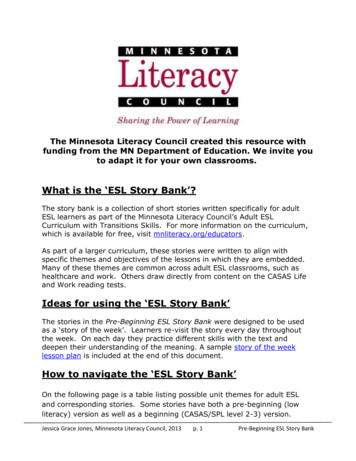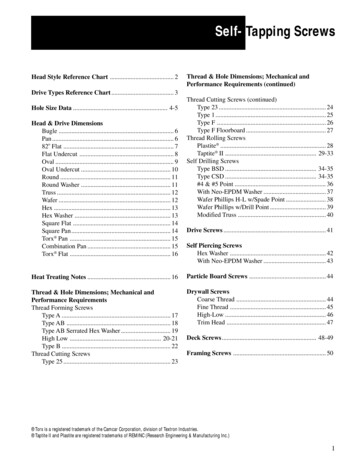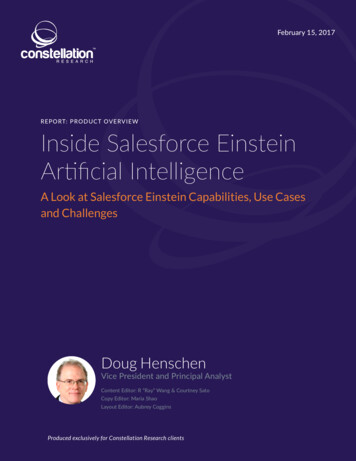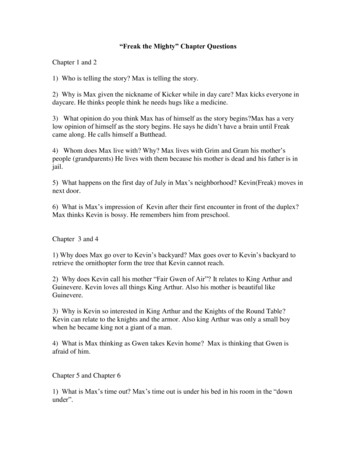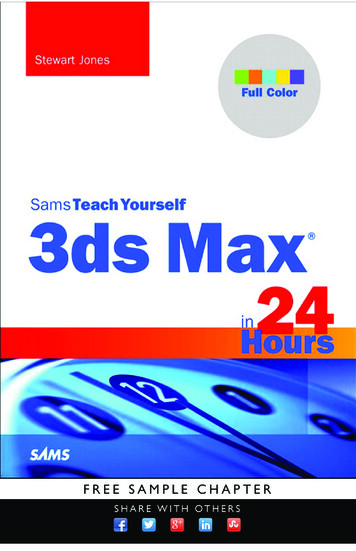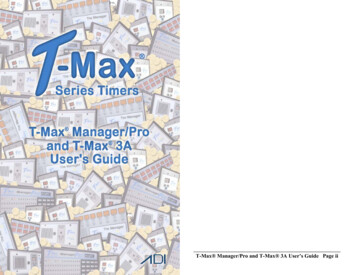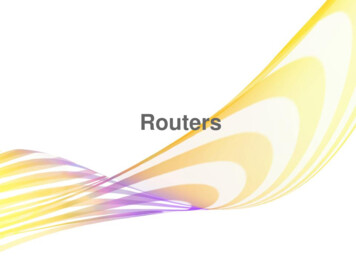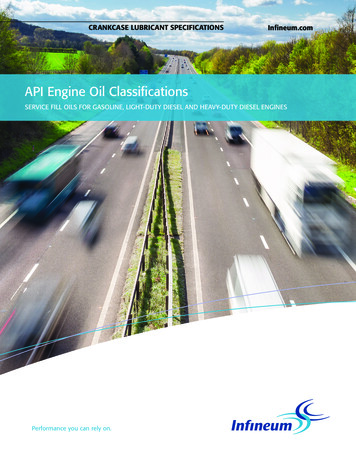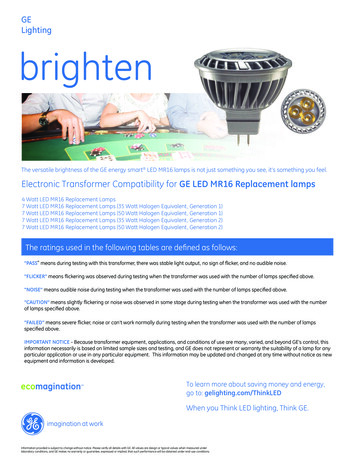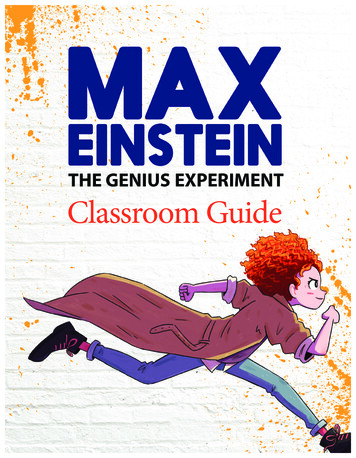
Transcription
Classroom Guide
MAXEINSTEIN5.375 7.875 SPINE: 1.1875James Patterson received theMAX EINSTEINMAX EINSTEIN:THE GENIUS EXPERIMENTClassroom GuideChris Grabenstein is a New York Timesbestselling author who has collaborated withJames Patterson on the I Funny, Treasure Hunters,and House of Robots series, as well as Jacky HaHa, Word of Mouse, Pottymouth and Stoopid, LaughOut Loud, and Daniel X: Armageddon. He lives inNew York City.Introduction to the Guidewill change the world!The first and only children’s adventure novelofficially approved by the Albert Einstein Archives“Max Einstein is everything you hopeyoung girls can dream to be:smart, brave, creative, and able toinspire others to be the same.I love this book for all kids who wantto dream big!”—Mayim Bialik, #1 New York Timesbestselling authorof Girling Up and Boying Up“Giveyour life!”this book to the future scientist inbestselling author—Jennifer L. Holm, New York Timesof The Fourteenth Goldfish“An inspirational page-turner that won’t let you down. This bookcelebrates the importance of young people’s new ideas andendless imaginations.”—Rachel Ignotofsky, New York Times bestselling authorof Women in Science and The Wondrous Workings of Planet Eartha rambunctious plot, aients: a feisty heroine,“Mix together these ingredand you have thisthat being smart is cool,nasty villain, and the notionbook!”aofoasterrollicking roller-candThe Wednesday Warsof Newbery Honor–winning—Gary D. Schmidt, authorFinalist Okay for NowNational Book AwardFind exclusives, trailers,and new releases onJAMESMAX EINSTEINPATTERSON THE GENIUS EXPERIMENTLiterarian Award for Outstanding Service to theAmerican Literary Community from the NationalBook Foundation. He holds the Guinness WorldRecord for the most #1 New York Times bestsellers,including Middle School, I Funny, and Jacky Ha-Ha,and his books have sold more than 380 millioncopies worldwide. A tireless champion of thepower of books and reading, Patterson createda children’s book imprint, JIMMY Patterson,whose mission is simple: “We want every kid whofinishes a JIMMY Book to say, ‘PLEASE GIVEME ANOTHER BOOK.’” He has donated morethan one million books to students and soldiersand funds over four hundred Teacher EducationScholarships at twenty-four colleges and universities. He has also donated millions of dollars toindependent bookstores and school libraries.Patterson invests proceeds from the sales of JIMMYPatterson Books in pro-reading initiatives.FLAPS: 3.5How mdoesto save tMax Einstein is a typGoes to school coPlays games speedTHE GENIUS EXPERIMENT“If you’reinterested inmysteries, or coura science,heroines,geousthisis a mustread—Chelsea Clinton!”jimmypatterson.orgDear Educator,LITTLE ,BROWNMaxEinstein 9780316523967 HC F1.indd 1And learns aboutAll normaUntil one day whena mysterious organizsolve some of the wousing science. She’s hgroup of young geniglobe as they inventthe farthest reachesthat’s only if the siniThe Corporation doAlso available in audio and ebook editions.Front jacket design by Gail Doobinin Jacket art by James LancettJacket 2018 Hachette Book Group, Inc. Printed in the U.S.A.Builds Lego towehelp the homeless4/C Composite with 2 PMS Inks: 2728 and 151;Printing over foil, embossing and spot glossIt is time to take your students on a new kind of adventure! Max Einstein: The Genius Experiment is writtenby James Patterson, author of the Middle School Series, and National Book Foundation’s 2015 LiterarianAward winner for Outstanding Service to the American Literary Community. This is the book your studentswant to read.Imagine one of your students has the opportunity to make the world a better place. That is exactly what Maxdoes in this book. Max Einstein is a 12- year-old girl who is a genius. While Max uses her knowledge forgood, this also causes some problems for her and others. There are two companies that are seeking her skills,the Change Makers Institute (CMI) and the Corp run by the evil Dr. Zimm. Max uses science, math, engineering, technology, and art to solve problems and frequently references her idol and imaginary pal, AlbertEinstein. The possible themes in this book are endless and will get your students to deepen their own thinking about the world around them. Your students will want to learn more about how Einstein has influencedtoday’s technological advances and take part in their own STEAM experiences.The purpose of this guide is to interact with the fun and engaging Max Einstein: The Genius Experimentwhile enlightening your students’ thinking through interdisciplinary activities that also connect to theCommon Core Standards*. Your students will learn all about Max and Albert Einstein and develop a specialfriendship with them. They will refer back to the book to remind themselves of all of Max’s adventures indifferent countries. Creativity and a willingness to go deeper are a must when completing the activities. Students will take part in their own social science experiment learning about others and the effects of kindness.Discussion questions will allow students to see their world in connection with the story. This is the book for21st century learners! Enjoy your adventure with Max Einstein!* Common Core Standards and activities may be adapted to fit your individual classroom needs, ages, abilities, and learning styles.
Interdisciplinary ActivitiesWho is Max Einstein?3English Language ArtsMax Einstein is the main character of the book. She has manypositive characteristics that guide her journey, and thesecharacteristics are revealed in significant events throughoutthe story. For example, Max shares her eagerness to create heat inthe stables by using horse manure. Ewwww! But how creative andthink-outside-the-box-ish of her! This is the first time we see Max asa scientist (page 6). Get students’ artistic and left-brain juices flowingby having them create a timeline of significant events from the bookthat reveal Max’s character. On the timeline, they can draw images thatrepresent plot events and then name Max’s characteristics that arerevealed. Does Max have positive and negative characteristics likereal people? Encourage students to discuss and explore!Take Max Einstein outside of the classroom for a real-world experienceand have students create a timeline about someone in their own family.How do their family member’s characteristics compare and contrastwith Max Einstein’s?!Common Core StandardsCCSS.ELA-Literacy.CCRA.R.3Analyze how and why individuals, events, or ideas develop andinteract over the course of a text.CCSS.ELA-Literacy.CCRA.W.9Draw evidence from literary or informational texts to supportanalysis, reflection, and research.
The Curious Albert Einstein3English Language Arts 3Art 3Social StudiesAlbert Einstein is everywhere! The alarm that gets you out of bed each morning or the GPS that takes you on a new adventure. He is the scientist who has impacted the world we live in today. Max refers to Albert Einstein in everything shedoes and experiences throughout the book. She wants to know everything about him and uses his scientific discoveriesand quotations to guide her thinking and actions. In this activity, the students bring Albert Einstein to life in their ownclassroom. They will become an expert on everything Albert Einstein (just like Max!). What did he like? What did he eat?What were his scientific discoveries? The students get to find out about the scientist who influenced the world we live intoday. Challenge students to find out something that surprised or intrigued them about Albert Einstein.Students research Albert Einstein using websites, videos, and books. Here are some topics to get them started, but remindthem that their exploration of knowledge does not have to stop here. After all, just like Albert Einstein said, “The important thing is not to stop questioning. Curiosity has its own reason for existing.” Born/Died - timelineFamilySchoolingWhat was his most important achievement?Why do you think this? Most influential quote - why it speaks to you Fun “think outside the box” facts.Did you know Albert Einstein never wore socks?He hated that they would get holes in them.Now’s the time for the creativity to flow! Students create a model of Einsteinusing modeling clay, paper mache, aluminum foil, a plastic bottle or anythingthey can get their hands on. Somewhere on or in the model, they shouldinclude the information found out about Albert Einstein. They can usetoothpicks, straws, or string with the information literally connected to it.Your classroom will be transformed into an information laboratory filledwith Albert Einsteins!WEBSITES ABOUT ALBERT EINSTEIN: Albert Einstein Biographyhttps://www.youtube.com/watch?v n4EjafCU5XY lbert Einstein history/albert-einstein/ Albert Einstein Factshttps://kids.kiddle.co/Albert EinsteinCommon Core StandardsCCSS.ELA-Literacy.CCRA.W.8Gather relevant information from multiple print and digital sources, assess the credibility and accuracy of each source, and integrate the informationwhile avoiding plagiarism.CCSS.ELA-Literacy.CCRA.W.9Draw evidence from literary or informational texts to support analysis, reflection, and research.CCSS.ELA-LITERACY.RH.6-8.1Cite specific textual evidence to support analysis of primary and secondary sources.CCSS.SL.5.5Include multimedia components (e.g., graphics, sound) and visual displays in presentations when appropriate to enhance the development of mainideas or themes.
Create a Commercial!3English Language Arts 3TechnologyMax is flown to Israel and taken immediately to the Change Makers Institute (CMI) where she learns for the first time whatthey want with her. Here she gets to meet the other geniuses (Max’s soon-to-be new friends) and together they visit andexplore the Albert Einstein Museum (pages 129-131). Max is so excited to tour the museum of her hero and see the itemsthat once belonged to her idol. Little does Max know, the evil Dr. Zimm has men waiting to collect her there! Luckily, Maxis observant and she uses her knowledge of the museum to escape the people working for Dr. Zimm.Just because Dr. Zimm’s crew is trying to nab Max at the museum, it doesn’t mean the museum is dangerous for all whovisit. It’s a treasure trove of Einsteins’ archives and fascinating for all. Tell your students to get ready to debut their actingskills! They will persuade tourists and others to visit the museum all about Albert Einstein. Students will create a commercial for the Albert Einstein Museum that Annika and Max visit. The commercial should include the items the girls werelooking at, which include 80,000 papers, artifacts, and treasures (page 129). Max and Annika also spend some time looking at letters, especially one written by a young child to Albert Einstein, suggesting he cut his hair. What a funny letter toinclude in a commercial! Encourage your students to get creative!Here is the website to the Albert Einstein Museum in Israel. This can helpstudents gather more knowledge about what will be in the museum.http://albert-einstein.org/Common Core StandardsCCSS.ELA-Literacy.CCRA.W.8Gather relevant information from multiple print and digital sources, assess the credibility andaccuracy of each source, and integrate the information while avoiding plagiarism.CCSS.ELA-Literacy.CCRA.W.9Draw evidence from literary or informational texts to support analysis, reflection, and research.CCSS.RI 5, RI 7Use age appropriate technologies to locate, collect, organize content from media collection forspecific purposes, citing sources
Kindness Counts Experiment3 English Language Arts 3Science 3MathThroughout the book, Max demonstrates her love of helping others. Students will have the chance to make a difference inthe lives of others while participating in a social science experiment. They will get to change the world around them andsee the power they have to make the world a better place. Brainstorm with students about the acts of kindness they haveexperienced/done/seen in school, at home, in public. Students can view one or both videos about kindness. Kid President - “How to Change the Worldwith Kindness” by Naomi Mullanehttps://ed.ted.com/on/iT4P09VO “Make Kindness a Habit” Sadie Zinn TEDxYouth@AnnArborhttps://www.youtube.com/watch?v ir0B0pnfzY0 Students share the examples of kindness they heard from the videos, how they made them feel and how thevideos connect to Max Einstein: The Genius Experiment.Now is the time for students to see acts of kindness in action! Students will complete the Kindness Experiment worksheetwith partners or in small groups to guide them through the experiment. Sentence prompts are provided to help spark theirthinking. Begin by sharing with students the Focus Question “How do acts of kindness affect others?” and have them makea prediction that answers the question. Next, the students need a plan of action to complete the experiment. Students willcarry out the plan and make observations of the acts of kindness they witness. Finally, students can look at their data andwrap up their experiment by making claims and evidence, concluding thoughts and reflecting. Encourage your studentsto see how this has changed the environment around them! When the experiment is complete, brainstorm with studentssmall (or big!) ways to spread kindness in their worlds. The Focus Question below is provided to get your students started.Common Core Standards/Next Generation Science StandardsCCSS.Math.Practice.MP3Construct viable arguments and critique the reasoning of others.CCSS.3-5-ETS1-2 Engineering DesignGenerate and compare multiple possible solutions to a problem based on how well each is likely to meet the criteria and constraints of the problem.CCSS.RI.5.9Integrate information from several texts on the same topic in order to write or speak about the subject knowledgeably. (3-5-ETS1-2)CCSS.W.5.8Recall relevant information from experiences or gather relevant information from print and digital sources; summarize or paraphrase information innotes and finished work, and provide a list of sources. (3-5-ETS1-1),(3-5-ETS1-3)
Kindness ExperimentScientific ProcessNameFocus Question(What is it you are trying to find out )DateHow do acts of kindness affect others?Prediction(When people are kind to other people, Ithink will happen, because .)Plan(Write out the step-by-step instructions forhow you will find the answer to the FocusQuestion)1.Observations(pictures, tallies, data tables, diagrams, etc.)Before Students carry a notebook for a week writingdown what they observed before, during, andafter the act(s) of kindness2.3.During After.Before During After.Before During After.
Claims and Evidence(I know because .)Conclusion(Today I learned .My prediction was correct, becauseI need to revise my prediction, because .)Reflection(I wonder if .Questions I now haveI used to think , but now I think .)
Essential Questions1. How does Max’s homelessness affect how shetreats others who are in the same situation?2. Which Albert Einstein quotation from the bookresonates with you the most? Why?3. What is a crisis you know about in the world thatyou would like to fix? Why is this important toyou?4. How might you interpret this quotation:“Only a life lived for others is a life worthwhile”?5. What do you think Dr. Zimm knows aboutMax’s past? What clues make you think this?6. Why do you think the author chooses to havethe identity of Max’s parents unknown to her?How does this affect the choices Max makesthroughout the book?7. Max helps Kabila and in return he helps her.How can you apply that to your life? When haveyou helped someone, and they helped you in return?How did this experience affect you or what did it teach you?8. ow does science affect your life for the better? When do you use science? How might science and creativity beHconnected? Has science ever had a negative effect on society or on people? Explain.9. How could you create the best problem-solving team? What characteristics do you need from your teammates?What characteristics would you bring to the team?10. hat characteristics are necessary to be a leader? Which characteristics does Max possess? Are there any qualitiesWabout Max that you would change to help her become an even better leader? Why or why not?
Max Einstein: The Genius ExperimentCrossword PuzzleNameDate1.7.2.3.5.6.4.AcrossDown1. A thought experiment developed in a bunch of6. The “E” in E MC² stands for (pg 47)letters between Albert Einstein and(pg 34)2. Albert Einstein’s Theory of (pg 26)3. We have cell phones and GPS thanks to the Theoryof Relativity and (2 words)(pg 26)4. Laws of Motion state a body at tends tostay at (pg 22)5. Max’s hero: Albert7. Rates of acceleration would depend on the massof the objects attempting to move isNewton’s 2nd Law of (pg 38)
Crossword PuzzleAnswer Key:AcrossDown1. S chrodinger6. energy2. relativity7. motion3. t ime dilation4. r est5. EinsteinSourcesAlbert Einstein Quotes. (n.d.). Retrieved from https://www.brainyquote.com/quotes/albert einstein 145949Biography. (n.d.). Retrieved from CQKlentschy, M. P. (2008). Using science notebooks in elementary classrooms. Arlington, VA: NSTA Press.This guide was written by Room 228 Educational Consulting, with public school teacher Michelle Assaad as leadteacher. We, like Max, are big daydreamers!
Patterson invests proceeds from the sales of JIMMY Patterson Books in pro-reading initiatives. Chris Grabenstein is a New York Times bestselling author who has collaborated with James Patterson on the I Funny, Treasure Hunters, and House of Robots series, as well as Jacky Ha-Ha, Word of Mous
